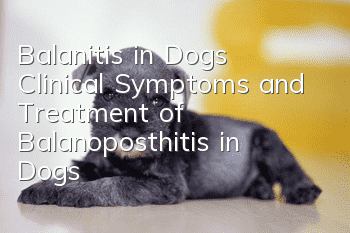Balanitis in Dogs Clinical Symptoms and Treatment of Balanoposthitis in Dogs

Clinical symptoms and treatment of balanoposthitis in dogs
Inflammation of the mucosa on the surface of the glans and foreskin in dogs is called balanoposthitis in dogs.
The causes of canine balanoposthitis:
1. Primary balanoposthitis is caused by bacterial infection.
2. Secondary can be caused by trauma, foreign bodies, and penile lymphoid tissue hyperplasia.
3. The spread of urinary tract infection, mating with female dogs suffering from reproductive tract diseases, etc. can also cause infection and inflammation.
Clinical symptoms of canine balanoposthitis:
1. Light green pus and smegma are often discharged from the foreskin hole and the penis is licked by oneself.
2. Penile lymphoid tissue hyperplasia is similar to a cyst, and the cyst cavity is filled with fluid. Mild stimulation (breeding, semen collection) can cause follicles to rupture and bleed, and sometimes even the entire mucosa to bleed.
3. If the affected dog is frequently bred or semen collected, causing continuous changes in the follicles, hemorrhagic cysts covering the glans may be formed. Such cysts will disappear on their own after 1 week of stopping breeding, and will not leave any trace. any trace.
Prevention and treatment measures for canine balanoposthitis:
1. Clean the foreskin with 1:4000 chlorhexidine solution twice a day. After cleaning, apply antibiotic ointment. For stubborn cases, rinse the foreskin mucosa with 200/0 copper sulfate solution.
2. Press out the penis every day for 5-7 days to ensure that no adhesion occurs.
3. If lymphoid tissue hyperplasia occurs, stricter treatment is required.
4. Anesthetize the animal under general anesthesia, scratch the lesion with gauze, and corrode the lesion with 5% silver nitrate solution.
5. Use corticosteroid ointment every day and monitor for adhesion and infection.
- Is it better for Dogo dogs to have their ears erect or cropped? A case of Dogo dog’s ear erection surgery will tell you
- What do dogs eat to protect their stomach? It is important to protect their stomach and treat gastrointestinal diseases in dogs.
- How to tell if your dog is fat? Is your dog overweight?
- How to train Tibetan Mastiff Four aspects teach you how to train Tibetan Mastiff
- Will your dog catch a cold if you blow the air conditioner? What should you do if your dog catches a cold if you blow the air conditioner?
- What should you pay attention to when your dog drinks water? Don’t be careless when it comes to your dog’s drinking water.
- The dog's mouth bites and shakes. Why does the dog's mouth occasionally shake and bite?
- How to cut a dog's hair? Do you know how to cut a dog's hair correctly?
- Can dogs eat raw eggs? Why can’t dogs eat egg whites?
- Common Dog Problems in Summer How to Deal with Different Dog Problems



